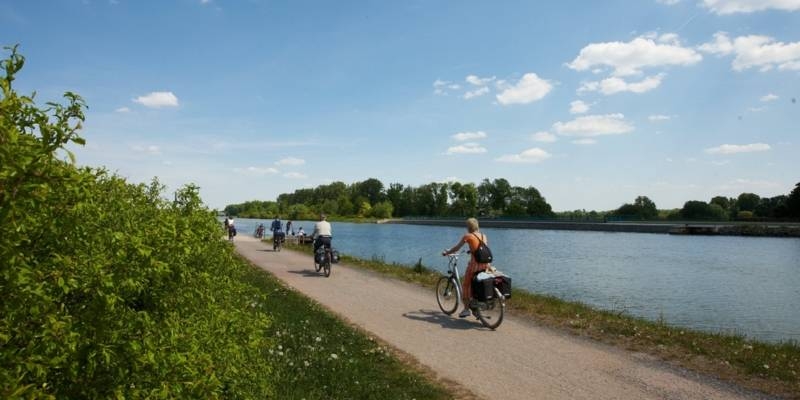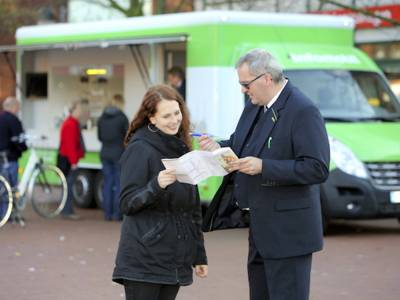Mobility
How to get from A to B in Hannover
Having arrived at the city, you are faced with the next question: How do I best get from A to B?
 © HMTG
© HMTG By bike through green Hanover!
The good news first of all: Hannover is characterized by an extremely compact city structure, many destinations can be reached quickly on foot or by bicycle. In addition, the well-developed bus and train network makes it easy to do without a car if necessary.
Cycling in Hannover
Cycling is fun in Hanover, because there are hardly any gradients to overcome. Cyclists can use the city's cycle paths (around 350 kilometres), with further cycle paths through the Eilenriede and on the banks of the Leine, Ihme and Mittellandkanal rivers.
 © Christian Wyrwa
© Christian Wyrwa To discover Hannover by bike
Hannover's most beautiful bike rides
Routes, tours, and tips for cycling in the cultural landscape of Hannover.
read moreBusses and Trains
While outsiders may ponder whether Hanover has a subway or trams, new arrivals will soon know that both are right. On the one hand, the trams of the Üstra transport company pass under the city centre like a subway in a tunnel system, on the other hand, they travel in the outer districts like a tram on the surface. In the mid-1970s, this principle called "Stadtbahn" was regarded worldwide as a role model and various delegations from transport companies and politicians visited Hanover at the time to inspect the light rail system. The light rail vehicles are supported by the city bus network, on which diesel, hybrid and electric buses are in use today. Interesting for night owls and party-goers: In order to bring passengers safely and comfortably to their destination at night on weekends, the trams in Hanover run in the so-called "Nachtsternverkehr" without a break.
Ticket or Card?
The tariff system of the Großraum-Verkehr Hannover (GVH) applies in the region of Hannover. The ticket prices depend on the number of zones the passenger wants to travel through. Actually quite simple, but of course there is also a special Hanoverian rule here.
Tickets are all tickets that are valid for up to one day. There are single tickets and group tickets for one-off trips, but also day tickets for individuals or groups. The price depends on the number of zones passed through. The GVH traffic area is divided into three tariff zones: Zone one is the city area of Hannover, zone two consists of neighbouring towns and municipalities ("surrounding countryside/Umland"), and the third zone, "Region", identifies places in the outer area of the Hannover Region.
Cards are all tickets that are valid for longer than one day (monthly, annual tickets). Here, too, the price depends on the number of zones passed through. However, four zones apply here, since the city area is divided into the zones "Hannover 1" and "Hannover 2". Once one has understood this, it is not so difficult at all. If you are still brooding, you will find a detailed explanation with graphics on the tariff page of the Üstra.
 © üstra
© üstra Die mobile Kundenberatung der üstra.
Üstra Customer Service
Those who prefer to be advised in conversation will find the Üstra customer office in Karmarschstraße in the city centre. Apropos customer service: Üstra's mobility consultants come to Langenhagen, Laatzen and Rethen with their Infomobil and thus save regional residents the trip to the city.
Driving a Car in Hannover
Hanover is the headquarters of Continental and Volkswagen Commercial Vehicles, and logistics is a high priority in the state capital. The fact that it is sometimes difficult to reach destinations in Hanover by car is therefore not due to a car-hostile attitude, but to the fact that the road network has not grown as fast as individual traffic in recent decades. But it is precisely the elimination of bottlenecks that leads to construction sites and thus to temporary new restrictions. A look at the current construction situation on Hanover's roads helps a lot (German only):
 Deutsch
Deutsch
 English
English
 中文
中文
 Danish
Danish
 Eesti
Eesti
 Español
Español
 Suomi
Suomi
 Français
Français
 Italiano
Italiano
 日本語
日本語
 한국
한국
 Nederlands
Nederlands
 Norge
Norge
 Polski
Polski
 Portugues
Portugues
 Русский
Русский
 Svenska
Svenska
 Türkçe
Türkçe
 العربية
العربية
 Romanesc
Romanesc
 български
български